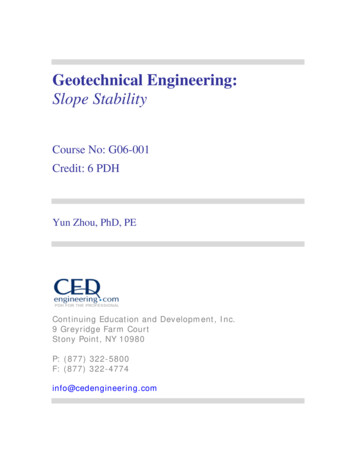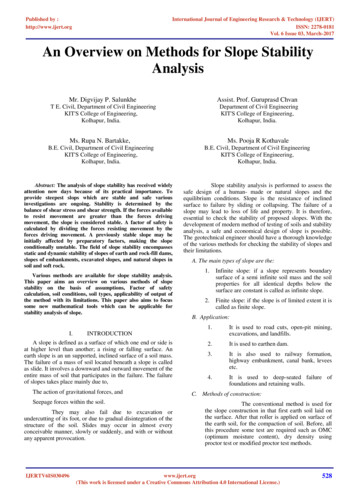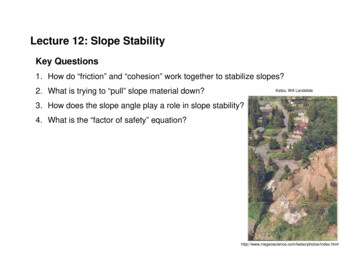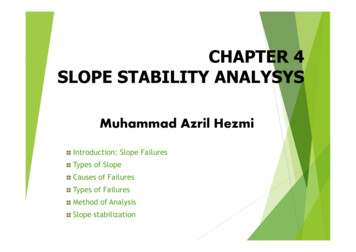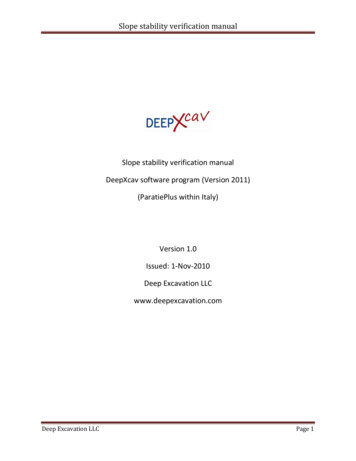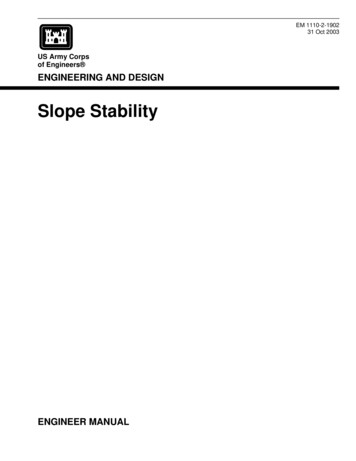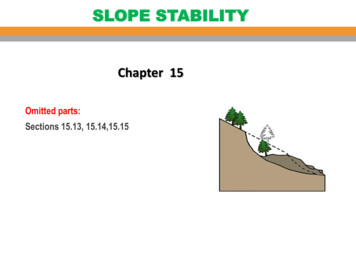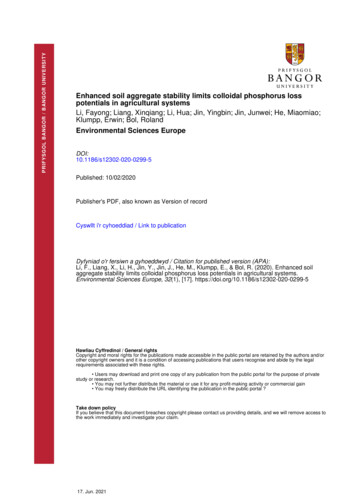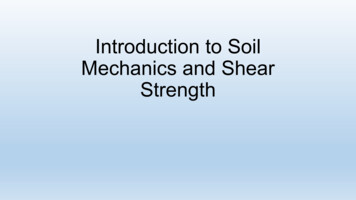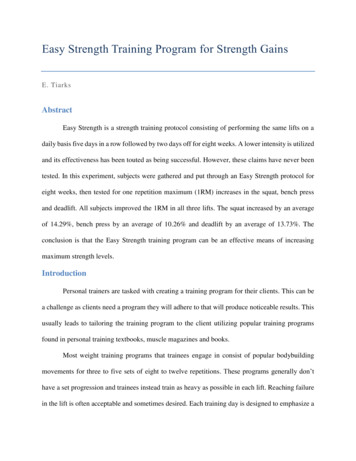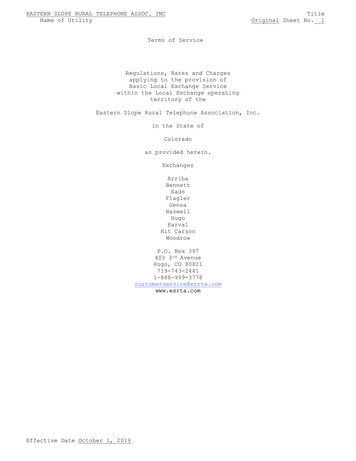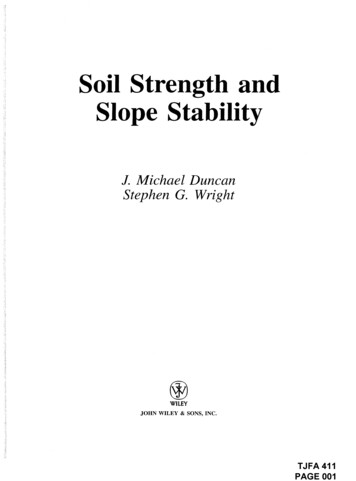
Transcription
Soil Strength andSlope StabilityJ. Michael DuncanStephen G. WrightWILEYJOHN WILEY & SONS, INC.TJ FA 411PAGE 001
CONTENTSPrefaceixCHAPTER 1INTRODUCTIONCHAPTER 2EXAMPLES AND CAUSES OF SLOPE FAILURECHAPTERCHAPTER 4CHAPTER 5CHAPTER 65Examples of Slope FailureCauses of Slope FailureSummary51417SOIL MECHANICS PRINCIPLES19Drained and Undrained ConditionsTotal and Effective StressesDrained and Undrained Shear StrengthsBasic Requirements for Slope Stability Analyses19212226STABILITY CONDITIONS FOR ANALYSES31End-of-Construction StabilityLong-Term StabilityRapid (Sudden) DrawdownEarthquakePartial Consolidation and Staged ConstructionOther Loading Conditions313232333333SHEAR STRENGTHS OF SOIL ANDMUNICIPAL SOLID WASTE35Granular MaterialsSiltsClaysMunicipal Solid Waste35404454MECHANICS OF LIMIT EQUILIBRIUMPROCEDURES55Definition of the Factor of SafetyEquilibrium ConditionsSingle Free-Body ProceduresProcedures of Slices: General55565763vTJ FA 411PAGE 002
viCONTENTSProcedures of Slices: Circular Slip SurfacesProcedures of Slices: Noncircular Slip SurfacesAssumptions, Equilibrium Equations, and UnknownsRepresentation of Interslice Forces (Side Forces)Computations with Anisotropic Shear StrengthsComputations with Curved Failure Envelopes andAnisotropic Shear StrengthsAlternative Definitions of the Factor of SafetyPore Water Pressure RepresentationCHAPTER 7CHAPTER 8CHAPTER 9CHAPTER 10CHAPTER 1163718383909O9195METHODS OF ANALYZING SLOPE STABILITY103Simple Methods of AnalysisSlope Stability ChartsSpreadsheet SoftwareComputer ProgramsVerification of AnalysesExamples for Verification of Stability Computations103105107107111112REINFORCED SLOPES AND EMBANKMENTS137Limit Equilibrium Analyses with Reinforcing ForcesFactors of Safety for Reinforcing Forces and Soil StrengthsTypes of ReinforcementReinforcement ForcesAllowable Reinforcement Forces and Factors of SafetyOrientation of Reinforcement ForcesReinforced Slopes on Firm FoundationsEmbankments on Weak Foundations137137139139141142142145ANALYSES FOR RAPID DRAWDOWN151Drawdown during and at the End of ConstructionDrawdown for Long-Term ConditionsPartial Drainage151151160SEISMIC SLOPE STABILITY161Analysis ProceduresPseudostatic Screening AnalysesDetermining Peak AccelerationsShear Strength for Pseudostatic AnalysesPostearthquake Stability Analyses161164165166169ANALYSES OF EMBANKMENTS WITH PARTIALCONSOLIDATION OF WEAK FOUNDATIONS175Consolidation during ConstructionAnalyses of Stability with Partial Consolidation175176TJ FA 411PAGE 003
CONTENTSviiObserved Behavior of an Embankment Constructed in Stages 178Discussion179CHAPTER 12CHAPTER 13CHAPTER 14CHAPTER 15CHAPTER 16ANALYSES TO BACK-CALCULATE STRENGTHS183Back-Calculating Average Shear StrengthBack-Calculating Shear Strength Parameters Based on SlipSurface GeometryExamples of Back-Analyses of Failed SlopesPractical Problems and Limitation of Back-AnalysesOther Uncertainties183185FACTORS OF SAFETY AND RELIABILITY199Definitions of Factor of SafetyFactor of Safety CriteriaReliability and Probability of FailureStandard Deviations and Coefficients of VariationCoefficient of Variation of Factor of SafetyReliability IndexProbability of Failure199200200202205206206IMPORTANT DETAILS OF STABILITY ANALYSES213Location of Critical Slip SurfacesExamination of Noncritical Shear SurfacesTension in the Active ZoneInappropriate Forces in the Passive ZoneOther DetailsVerification of CalculationsThree-Dimensional Effects213219221224228232233PRESENTING RESULTS OF STABILITYEVALUATIONS237Site Characterization and RepresentationSoil Property EvaluationPore Water PressuresSpecial FeaturesCalculation ProcedureAnalysis Summary FigureParametric StudiesDetailed Input DataTable of Contents237238238238239239241243243SLOPE STABILIZATION AND REPAIR247Use of Back-AnalysisFactors Governing Selection of Method of Stabilization247247187195197TJ FA 411PAGE 004
viiiCONTENTSAPPENDIXDrainageExcavations and Buttress FillsRetaining StructuresReinforcing Piles and Drilled ShaftsInjection MethodsVegetationThermal TreatmentBridgingRemoval and Replacement of the Sliding Mass248253254256260261261262263SLOPE STABILITY CHARTS265Use and Applicability of Charts for Analysis ofSlope StabilityAveraging Slope Inclinations, Unit Weights, andShear StrengthsSoils with 0Soils with 0Infinite Slope ChartsSoils with 0 and Strength Increasing with ex295TJ FA 411PAGE 005
BASIC REQUIREMENTS FOR SLOPE STABILITY ANALYSES27surface and (2) the shear stress required for equilib- the soil. If these conditions prevail in all the soils at arium.site, or if the conditions at a site can reasonably beThe factor of safety for the shear surface is the ratio approximated by these conditions, a drained analysisof the shear strength of the soil divided by the shear is appropriate. A drained analysis is performed using:stress required for equilibrium. The normal stresses Total unit weightsalong the slip surface are needed to evaluate the shearstrength: Except for soils with b 0, the shear Effective stress shear strength parameters Pore pressures determined from hydrostatic waterstrength depends on the normal stress on the potentiallevels or steady seepage analysesplane of failure.In effective stress analyses, the pore pressures alongthe shear surface are subtracted from the total stresses Analyses of Undrained Conditionsto determine effective normal stresses, which are used Undrained conditions are those where changes in loadsto evaluate shear strengths. Therefore, to perform ef- occur more rapidly than water can flow in or out offective stress analyses, it is necessary to know (or to the soil. The pore pressures are controlled by the beestimate) the pore pressures at every point along the havior of the soil in response to changes in externalshear surface. These pore pressures can be evaluated loads. If these conditions prevail in the soils at a site,with relatively good accuracy for drained conditions, or if the conditions at a site can reasonably be approxwhere their values are determined by hydrostatic or imated by these conditions, an undrained analysis issteady seepage boundary conditions. Pore pressurescan seldom be evaluated accurately for undrained appropriate. An undrained analysis is performed using:condtions, where their values are determined by the Total unit weightsresponse of the soil to external loads. Total stress shear strength parametersIn total stress analyses, pore pressures are not subtracted from the total stresses, because shear strengthsare related to total stresses. Therefore, it is not neces- How Long Does Drainage Take?sary to evaluate and subtract pore pressures to perform As discussed earlier, the difference between undrainedtotal stress analyses. Total stress analyses are applica- and drained conditions is time. The drainage characble only to undrained conditions. The basic premise of teristics of the soil mass, and its size, determine howtotal stress analysis is this: The pore pressures due to long will be required for transition from an undrainedundrained loading are determined by the behavior of to a drained condition. As shown by Eq. (3.1):the soil. For a given value of total stress on the potential failure plane, there is a unique value of pore pres02sure and therefore a unique value of effective stress.t99 4(3.17)CvThus, although it is true that shear strength is reallycontrolled by effective stress, it is possible for the undrained condition to relate shear strength to total nor- where t99 is the time required to reach 99% of drainagemal stress, because effective stress and total stress are equilibrium, D the length of the drainage path, and couniquely related for the undrained condition. Clearly, the coefficient of consolidation.this line of reasoning does not apply to drained con- Values of co for clays vary from about 1.0 cm2/hditions, where pore pressures are controlled by hy- (10 ft2/yr) to about 100 times this value. Values of codraulic boundary conditions rather than the response for silts are on the order of 100 times the values forclays, and values of co for sands are on the order ofof the soil to external loads.100 times the values for silts, and higher. These typicalvalues can be used to develop some rough ideas of theAnalyses of Drained Conditionslengths of time required to achieve drained conditionsDrained conditions are those where changes in loadin soils in the field.are slow enough, or where they have been in place longDrainage path lengths are related to layer thickenough, so that all of the soils reach a state of equilibnesses. They are half the layer thickness for layers thatrium and no excess pore pressures are caused by theare bounded on both sides by more permeable soils,loads. In drained conditions pore pressures are conand they are equal to the layer thickness for layers thattrolled by hydraulic boundary conditions. The waterare drained only on one side. Lenses or layers of siltwithin the soil may be static, or it may be seepingor sand within clay layers provide internal drainage,steadily, with no change in the seepage over time andreducing the drainage path length to half of the thickno increase or decrease in the amount of water withinness between internal drainage layers.TJ FA 411PAGE 006
CHAPTER 5Shear Strengths of Soil and Municipal Solid WasteA key step in analyses of soil slope stability is mea- angle of internal friction. Measuring or estimating thesuring or estimating the strengths of the soils. Mean- drained strengths of these materials involves determiningful analyses can be performed only if the shear ing or estimating appropriate values of b’.The most important factors governing values of b’strengths used are appropriate for the soils and for theparticular conditions analyzed. Much has been learned for granular soils are density, confining pressure, grainabout the shear strength of soils within the past 60 size distribution, strain boundary conditions, and theyears, often from surprising and unpleasant experience factors that control the amount of particle breakagewith the stability of slopes, and many useful research during shear, such as the types of mineral and the sizesstudies of soil strength have been performed. The and shapes of particles.amount of information that has been amassed on soilstrengths is very large. The following discussion fo- Curvature of Strength Envelopecuses on the principles that govern soil strength, theissues that are of the greatest general importance in Mohr’s circles of stress at failure for four triaxiat testsevaluating strength, and strength correlations that have on the Oroville Dam shell material are shown in Figurebeen found useful in practice. The purpose is to pro- 5.1. Because this material is cohesionless, the Mohrvide information that will establish a useful framework Coulomb strength envelope passes through the originand a point of beginning for detailed studies of the of stresses, and the relationship between strength andeffective stress on the failure plane can be expressedshear strengths of soils at particular sites.by Eq. (5.1).A secant value of b’ can be determined for each ofthe four triaxial tests. This value corresponds to a linGRANULAR MATERIALSear failure envelope going through the origin and passThe strength characteristics of all types of granular ing tangent to the circle of stress at failure for thematerials (sands, gravels, and rockfills) are similar in particular test, as shown in Figure 5.1. The dashed linemany respects. Because the permeabilities of these ma- in Figure 5.1 is the linear strength envelope for the testterials are high, they are usually fully drained in thewith the highest confining pressure. The secant valuefield, as discussed in Chapter 3. They are cohesionless: of 4" for an individual test is calculated asThe particles do not adhere to one another, and theireffective stress shear strength envelopes pass throughthe origin of the Mohr stress diagram.The shear strength of these materials can be characterized by the equation(5.2)where rls and o-;s are the major and minor principalstresses at failure. Secant values of b’ for the tests onOroville Dam shell material shown in Figure 5.1 arewhere s is the shear strength, or’ the effective normal given in Table 5.1, and the envelope for o-; 4480stress on the failure plane, and b’ the effective stress kPa is shown in Figure 5.1.s o-’ tan b’(5.1)35TJ FA 411PAGE 007
365SHEAR STRENGTHS OF SOIL AND MUNICIPAL SOLID WASTE1500Oroville Dam shellInitial void ratio 0.22Max. particle size 6 in.Specimen dia. 36 in.1 psi 6.9 kPalO00 38.2 degrees secant Zfor 3’ 650 psi 4480 kPaCurved strength envelope5OO0500100015002000Effective normal stress - ’ - psi25003000Figure 5.1 Mohr’s circles of shear stress at failure and failure envelope for triaxial tests onOroville Dam shell material. (Data from Marachi et al., 1969.)Table 5.1 Stresses at Failure and Secant Values of4 ’ for Oroville Dam Shell MaterialTest r’1 (kPa)4,’ 4,0 - A4’ ]Og,o o-3Pa(5.3)4,’ (deg)where 4’’ is the secant effective stress angle of internalfriction, 4’o the value of b’ for o-; 1 atm, A4, the46.812101,330reduction in 4,’ for a 10-fold increase in confining pres43.429705,200sure, o-; the confining pressure, and Pa atmospheric39.8313,2002,900pressure. This relationship between 4,’ and o-; is shown38.2419,1004,480in Figure 5.2a. The variation of h’ with o-; for theOroville Dam shell material is shown in Figure 5.2b.Values of 4,’ should be selected considering the confininginvolved in the conditions being anaThe curvature of the envelope and the decrease in lyzed. pressuresSomeslopestability computer programs havethe secant value of 4,’ as the confining pressure inprovisionsforusingfailure envelopes, which iscreases are due to increased particle breakage as the an effective means curvedofrepresentingvariations of 4,’confining pressure increases. At higher pre
Simple Methods of Analysis Slope Stability Charts Spreadsheet Software Computer Programs Verification of Analyses Examples for Verification of Stability Computations REINFORCED SLOPES AND EMBANKMENTS Limit Equilibrium Analyses with Reinforcing Forces Factors of Safety for Reinforcing Forces and Soil Strengths Types of Reinforcement Reinforcement Forces Allowable
